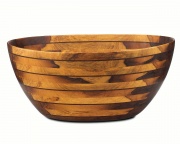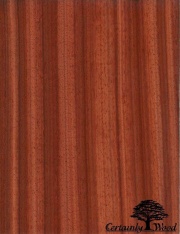Difference between revisions of "Padauk"
Jump to navigation
Jump to search
(username removed) |
|||
| (2 intermediate revisions by 2 users not shown) | |||
| Line 1: | Line 1: | ||
| − | [[File:1984.66-SC58785.jpg|thumb|]] | + | [[File:1984.66-SC58785.jpg|thumb|African padauk bowl<br>MFA# 1984.66]] |
== Description == | == Description == | ||
| − | + | [[File:padaukwc.jpg|thumb|Padauk (''Pterocarpus dalbergioides'')]] | |
| − | A deep red wood obtained from tropical trees, ''Pterocarpus indicus'' and ''Pterocarpus dalbergioides'', found in southeast Asia, Africa and the Andaman islands. Padauk may have a mottled surface with bright red or black streaks. It is a hard, strong wood that is naturally durable. Padauk is used for decorative cabinetwork, turnery, veneer, piano cases and parquet. A related species, Burma padauk from the ''Pterocarpus macrocarpus'' tree has a harder more yellowish wood. | + | A deep red wood obtained from tropical trees, ''Pterocarpus indicus'' and ''Pterocarpus dalbergioides'', found in southeast Asia, Africa, and the Andaman islands. Padauk may have a mottled surface with bright red or black streaks. It is a hard, strong wood that is naturally durable. Padauk is used for decorative cabinetwork, turnery, veneer, piano cases and parquet. A related species, Burma padauk from the ''Pterocarpus macrocarpus'' tree has a harder more yellowish wood. |
== Synonyms and Related Terms == | == Synonyms and Related Terms == | ||
| Line 8: | Line 8: | ||
''Pterocarpus indicus; Pterocarpus dalbergioides''; padauk; corail (Fr.); pau rosa de Timor (Port.); amboyna; padouk; vermilion wood; corail | ''Pterocarpus indicus; Pterocarpus dalbergioides''; padauk; corail (Fr.); pau rosa de Timor (Port.); amboyna; padouk; vermilion wood; corail | ||
| − | + | ==Physical and Chemical Properties== | |
| − | + | * Heartwood ranges from pale pink to to deep brownish red, darkening with time | |
| − | + | * Grain is interlocked with a coarse texture and open pores | |
| − | + | * Wood is resistant to decay and insects | |
| − | + | * Density = 45-55 ppcf | |
| − | |||
| − | == | + | ==Working Properties== |
| + | * Easy to work; tearout may occur during planing on quartersawn or interlocked grain | ||
| + | * Turns, glues, and finishes well. | ||
| + | ==Resources and Citations== | ||
| + | The Wood Database: [https://www.wood-database.com/andaman-padauk/ Andaman Paduauk] | ||
* G.S.Brady, ''Materials Handbook'', McGraw-Hill Book Co., New York, 1971 Comment: p. 434 | * G.S.Brady, ''Materials Handbook'', McGraw-Hill Book Co., New York, 1971 Comment: p. 434 | ||
Latest revision as of 13:52, 2 October 2022
Description
A deep red wood obtained from tropical trees, Pterocarpus indicus and Pterocarpus dalbergioides, found in southeast Asia, Africa, and the Andaman islands. Padauk may have a mottled surface with bright red or black streaks. It is a hard, strong wood that is naturally durable. Padauk is used for decorative cabinetwork, turnery, veneer, piano cases and parquet. A related species, Burma padauk from the Pterocarpus macrocarpus tree has a harder more yellowish wood.
Synonyms and Related Terms
Pterocarpus indicus; Pterocarpus dalbergioides; padauk; corail (Fr.); pau rosa de Timor (Port.); amboyna; padouk; vermilion wood; corail
Physical and Chemical Properties
- Heartwood ranges from pale pink to to deep brownish red, darkening with time
- Grain is interlocked with a coarse texture and open pores
- Wood is resistant to decay and insects
- Density = 45-55 ppcf
Working Properties
- Easy to work; tearout may occur during planing on quartersawn or interlocked grain
- Turns, glues, and finishes well.
Resources and Citations
The Wood Database: Andaman Paduauk
- G.S.Brady, Materials Handbook, McGraw-Hill Book Co., New York, 1971 Comment: p. 434
- Ralph Mayer, A Dictionary of Art Terms and Techniques, Harper and Row Publishers, New York, 1969 (also 1945 printing)
- F. H. Titmuss, Commercial Timbers of the World, The Technical Press Ltd., London, 1965

